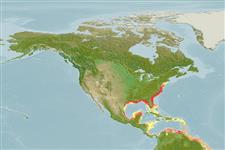Common names from other countries
>
Eupercaria/misc (Various families in series Eupercaria) >
Sciaenidae (Drums or croakers)
Etymology: Sciaenops: Greek, skiaina, skion = a fish, red mullet + Greek, ops = appearance (Ref. 45335).
More on author: Linnaeus.
Environment: milieu / climate zone / depth range / distribution range
Ecologia
marino; salmastro demersale; oceanodromo (Ref. 51243); distribuzione batimetrica 10 - ? m (Ref. 9988). Subtropical; 15°C - 26°C (Ref. 127841); 43°N - 0°S
Western Atlantic: Massachusetts in USA to northern Mexico, including southern Florida, USA.
Length at first maturity / Size / Peso / Age
Maturity: Lm 82.7, range 55 - 80.3 cm
Max length : 155 cm TL maschio/sesso non determinato; (Ref. 3702); common length : 100.0 cm TL maschio/sesso non determinato; (Ref. 3702); peso massimo pubblicato: 45.0 kg (Ref. 9988); Età massima riportata: 50 anni (Ref. 32563)
Occurs usually over sand and sandy mud bottoms in coastal waters and estuaries. Abundant in surf zone. Feeds mainly on crustaceans, mollusks and fishes. Utilized fresh and frozen; can be pan-fried, broiled and baked (Ref. 9988).
Robins, C.R. and G.C. Ray, 1986. A field guide to Atlantic coast fishes of North America. Houghton Mifflin Company, Boston, U.S.A. 354 p. (Ref. 7251)
IUCN Red List Status (Ref. 130435)
CITES (Ref. 128078)
Not Evaluated
Human uses
Pesca: scarso interesse commerciale; Acquacoltura: commerciale; Pesce da pesca sportiva: si; Acquario: Acquari pubblici
Strumenti
Special reports
Download XML
Fonti Internet
Estimates based on models
Preferred temperature (Ref.
115969): 15.5 - 27.3, mean 24.2 (based on 180 cells).
Phylogenetic diversity index (Ref.
82804): PD
50 = 1.0000 [Uniqueness, from 0.5 = low to 2.0 = high].
Bayesian length-weight: a=0.00832 (0.00523 - 0.01324), b=3.07 (2.94 - 3.20), in cm Total Length, based on LWR estimates for this species & (Sub)family-body (Ref.
93245).
Trophic level (Ref.
69278): 3.7 ±0.57 se; based on food items.
Resilienza (Ref.
120179): Medio, tempo minimo di raddoppiamento della popolazione 1.4 - 4.4 anni (K=0.27; tmax=7; Fec~1 million).
Fishing Vulnerability (Ref.
59153): Moderate vulnerability (44 of 100).
Climate Vulnerability (Ref.
125649): Very high vulnerability (88 of 100).
